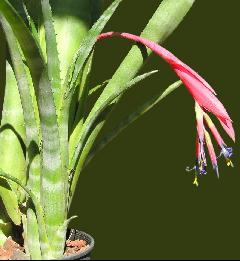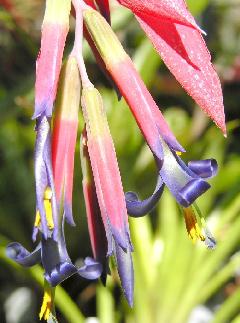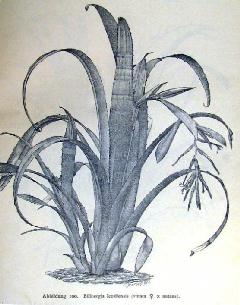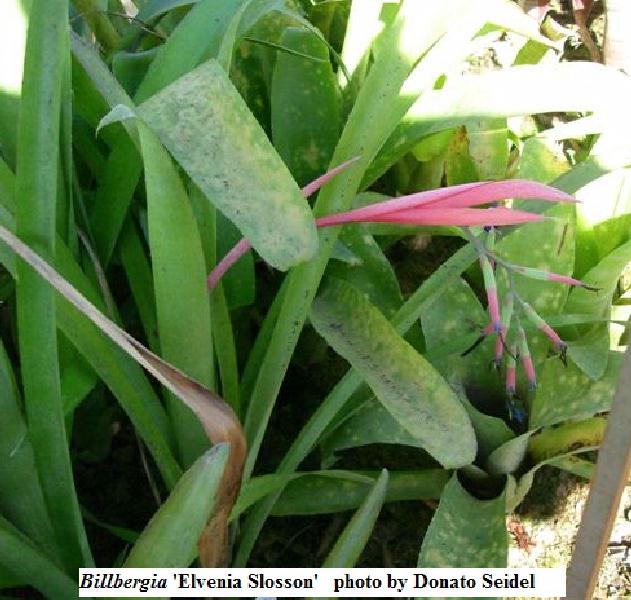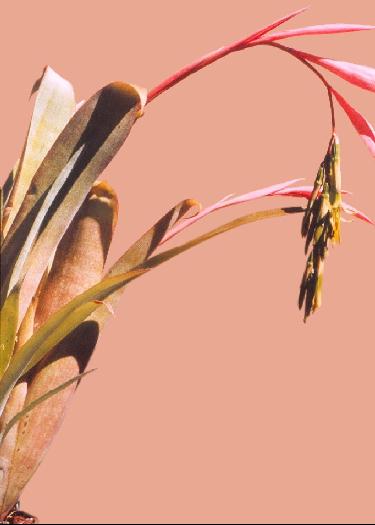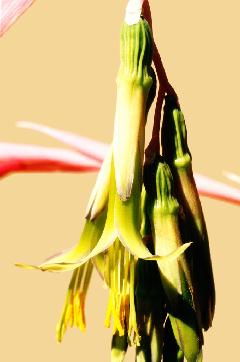Let us go back to 1981 when Bernard Stonor wrote in ‘Bromlink’ (WA Soc newsletter) 2(3):7.1981. (Bernard was one of the early stalwarts in Bromeliaceae in Australia.)
“B. x leodiensis (nutans x vittata) was originally grown in many collections (in Australia) as B. ‘Elvenia Slosson’ but now that details of these two hybrids are known there seems little doubt that B. x leodiensis is correct. B. ‘Elvenia Slosson’ is said to be nutans x ‘Albertii’ with ‘Albertii’ being distachia x nutans. This suggests the plant would be very close to nutans!”
This sounds reasonable enough but I did not really know what B. ‘Leodiensis’ was supposed to look like. Thanks to Leo Dijkgraaf from the Netherlands I now have a copy of Gartenflora 1891 where Witte describes this new hybrid. Needless to say this opened a can of worms again showing that hybridists in California in the early days of the BSI guessed what they were doing. First let us look at what Witte had to say. He was a gardener at Leiden, Holland and had problems with the academics of his day!
Billbergia leodiensis H. L. B. and Billbergia Intermedia H. L. B. by H Witte. in Gartenflora 40: 563-9. 1891
H. L. B. stands for Hortus (Academicus) Lugduno Batavus, this name goes back to a Roman settlement near Leiden called Lugdunum Batavorum; so it is Hortus Leiden.
Translated by Butcher & Leo Dijkgraaf
In the month of December 1889 two Billbergias came into flower at the Leiden University Botanical Garden, which greatly interested me and probably everyone else that I informed of its origin.
They were two hybrids from the same named parents in fact, but then the plants themselves showed a strongly distinct difference. Both were descendants well known and much cultivated Billbergia vittata (fig. 99), and B. nutans (fig. 102), but in the reverse positions. The one that had Billbergia nutans as the mother and vittata as the father (B. intermedia, fig., 101), and the reverse, (B. leodiensis, fig., 100).
When I showed these plants to a systematics-specialist and he looked at all four plants (both parents standing at one end), he called it a scientifically very interesting example of hybridisation, but "if we continue in this way", he added, "will flora itself mistake her children, and how will it then be possible to conform everything with rules and laws, to distinguish hybrids from species?"
I say this is possible and in my opinion it is not so relevant when a hybrid is regarded as a species.
One must assume however that most of the species of truly hybrid origin are; and whether nature that uses the wind, the insects or human being, to transmit pollen, is actually all the same however; as well whether a hybrid originated now, or whether it originated centuries ago, and the science learned, to know it as a species. Most important thing is firstly that we have the plants, secondly that we distinguish them, and also make both things possible for other people.
He shook his head, and laughed. Some days later I showed him the photos of these four plants, in the same sequence, glued on cardboard, he was quite content.
I sent printings of it also to the Senior executive officer Professor Dr. Wittmack, who is specifically interested in Bromeliads; I told him that I had received one from Berlin, and others from the Liege Botanical Garden, and left it to him, whether he wanted to use this communication in “Gartenflora”.
Prof. Dr. Wittmack however had already sent me, a couple of months before, illustrations of very exact copies which had been prepared from the photographs, and requested me to write more text for it, which was somewhat inconvenient, since I had so much to write, and also, because I am not as comfortable with the German language, as with Dutch.
I console myself however with the thought, that I will be better in German, than if he did it in Dutch. Further he must now see it legibly as he does my chitchat, that carries also a rather hybrid character!
I got one of the two plants, which is in my article here, in 1887 from my colleague, Herr Marechal, from the botanical garden in Liege, under the name Billbergia vittato-nutans. It was grown by the unfortunately too early deceased bromeliographer Ed. Morren from seeds of B. vittata, that had been fertilized with pollen from B. nutans. {* See below}.
In 1889, a duplicates list sent from my colleague Mr. Perring from Berlin of Bromeliads to exchange. Under the same name, I found Billbergia nutans x vittata, a hybrid cultivated in the Berlin Botanical Garden, from seeds of B. nutans, that had been fertilised with pollen from B. vittata. Therefore in reverse.
Not since that time had the former plant flowered here, but flowering was soon to occur, I had also much interest in the second one in order to see how far different these two hybrids were or how similar.
Mr. Perring had the kindness to send me a strong plant of the Berlin hybrid, and so both flowered simultaneously in the winter 1890/91 in the Orchid House.
The two plants look so different that one should not suspect that they are so closely related, and yet, when compared with the two parents, it is undeniable that both must be viewed as an inter-form.
With one, where B. nutans is the mother, (B. intermedia, fig., 101), its habit has remained more or less similar to the leaf form of the mother, modified only visibly through the influence of vittata. The same is with the other the case, so that the habit (B. leodiensis, fig., 100) is rather near to vittata; however the effect of the father, B. nutans, in size, is such that nobody would consider it vittata, but as a strongly modified B. nutans.
Already the Liege plant new from Professor Morren had flowered, and reported by Baker in “Handbook of the Bromeliaceae”. As it is known, Morren's rich collection of original illustrations of Bromeliaceae became the property of Kew Gardens, and probably gave Baker incentive in the publication of his monograph. On page 83 No. 38 he gives a description of Billbergia vittato-nutans Hort. Makoy, after a plant, which flowered in March 1888 at Kew. He says there that Morren’s illustrations occur in two different forms of this hybrid, one that has shorter stiffer leaves than the one he described that recurve from low down. So both forms must have flowered earlier with Morren (the hybrid did not come from Makoy but from the botanical garden in Liege).
Since the Baker’s hybrid name seemed unsuitable to me (and also others), and this plant still had no other name, I named it Billbergia leodiensis, (the Liege Billbergia, Fig. 100).
As said, this plant not at all resembles its father, B. nutans, resembles however more through the leaf form of the mother, B. vittata, although the leaves are much strongly bent over. They are more narrow and flabby, and show only a weak touch of the white cross-lines that are so strongly marked in vittata. The spines on the leaf edge are smaller than with vittata.
Therefore B. nutans had a clear influence on the leaves, and even more strongly visible in the flower.
The inflorescence has from the middle a long bent over scape, and reminds on the whole more nutans than vittata: whose scape is stronger and not bent over and nodding ( nutant), that is, not bent suddenly at the top but up to half bend over; it is however stiffer than vittata. The bracts or here better ‘transition bracts’ (Scape bracts, anaphylla - after Wittmack) that involves stature, form and number is more near to nutans than reminiscent to vittata.
It is clear, that the character of the father (nutans) is prevalent in its flowers, by virtue of all its parts. (Now, with the sample before me, casually looking at the flowers of the two hybrids again, they are much stronger and beautiful. The scape is longer, the inflorescence much stronger, branches below; it is no longer similar to nutans, but suits the two parents as know).
The Ovary is light green, 13mm long, the calyx pink coloured, with dark-blue tips. The petals are 2cm longer than the tips of the calyx, green only at the lowermost end, blue above. Against the light is seen the greenish mid rib of the petal. The filament is as long as the petal; the stigma is green.
If you follow Baker's method the Berlin hybrid should be called B. nutanto-vittata. I used the name Billbergia intermedia H. L. B. (Illustration 100), because it is clear it is in the middle between nutans and leodinensis. In the habit of the form of the leaf, this is similar to the hybrid with B. nutans, only much stronger in its development, so that you might consider it a quite another species. The plant offsets like nutans as well; the leaves stand stiffly, straight erect and only bent over at its top; they reach 90cm long and 3cm wide.
The inflorescence comes closer to that of nutans then to Billbergia leodiensis.
The pink coloured ‘transition bracts’, 5 in number, have the same form and stand completely like nutans; the middle, the third and the largest, is 8cm long, 1.5cm wide, (Now the largest is 11cm long, 2cm wide). All somewhat white powdered (like bran) and surround the tips of the lowermost flowers. These, 6 in number (Now more than the double, 15-17; also there is a three flowered, lowermost flower-stalk so that panicle shows an inclination to branch.) are not stemmed, and have only very small, hardly visible, densely adjacent to the ovary, red scale-like bracts.
The ovary is green, 1cm long. The calyx is red, with blue tips, 2cm long, and the corolla 2cm long. The petals are bent backwards, green at the base, further above blue, with a greenish touch. The filaments seem to be the same length as the corolla, but in reality a little shorter. The stigma is strongly twisted, blue.
On the whole you can say that this plant is a very much-improved form of Billbergia nutans. The plant is much stronger and the flowers more appealing.
Just as with the little similar B. leodiensis, it can be spoken here as having a nutant scape, a nodding shaft. This shows that the nodding inflorescence character has been lost in the two hybrids. The scape of B. nutans stands in the low part stiffly erect, but is flabby in the hybrids. In the remaining comes the flower stem, in which bracts and the flowers show the character of B. nutans.
To say, that these two plants are an important improvement would be, seen from a floristic point of view, saying too much.
There are more beautiful ones in this rich bromeliad genus.
But they are an asset anyway; the plants by themselves are already strong and maintaining a flowering period are graciously named.
Interesting is the example of the influence of the foreign pollen. B. vittata and nutans are quite different plants, and the two hybrids stand so exactly between them that these four represent an impressive row; the two between forms so to speak, connect the two others with each other.
The enclosed illustrations show that most clearly.”
After reading this and looking at the ‘photograph’ I think I have an idea of what B. ‘Leodiensis’ looks like and can confirm Bernard’s decision that we have B. ‘Leodiensis’ or a plant with similar parentage in Australia.
But what about this plant that arrived in Australia as ‘Elvenia Slosson’? All I can find is this, because it was not formally registered.
Billbergia ‘Elvenia Slosson’
From Padilla in Brom Soc Bull 12(4): 71. 1962
James N. Giridlian, of Oakhurst Gardens in Arcadia, California, has made a number of noteworthy Billbergia crosses. One of his first is B. x'Elvenia Slosson', named in honor of a prominent garden club leader. This is an exceedingly graceful Billbergia, with very long, strap-shaped deep green leaves, which turn purplish bronze in the sun. The attractive inflorescence with its bright red bracts and deep purple flowers may measure from 24 to 36 inches. This Billbergia makes a handsome pot plant.
From Padilla in Bromeliads 1973
'Elvenia Slosson' Giridlian (B. nutans x B. albertii?). The very long, strap-shaped, dark green leaves turn purplish bronze in the sun. The bracts are bright red; the petals, deep purple. The flowering plant is about 3 feet high.
It appears that ‘Elvenia Slosson’ came into being just after WW2 so it was some years before the parents were made known. To help us decide how a hybrid can get deep purple petals we need to know a bit more about this B. albertii.
Billbergia ‘Albertii’
From Padilla in Brom Soc Bull 12(4): 1962
Some Billbergias found in nurseries do have names, however; but, unfortunately, many of these are erroneous. For example, some of us have a Billbergia known as B. x "Albertii." Its origin is uncertain, and Mulford Foster insists that there is no such plant. Perhaps this Billbergia is a distachia cross, but we do not know. It is a stocky, broad-leaved tubular plant with dull green leaves suffused with light purple and creamy-white spots, then dusted over with a fine white powder. Regardless of its doubtful origin, this is an attractive Billbergia.
Magically in BSI –ICBH-1979 parents of distachia x nutans appear !
Here again we do have an ‘Albertii’ in Australia and it does show traits of B. distachia in its flowers by having more green in the petals (not mentioned in Padilla’s description)
Let us now return to ‘Elvenia Slosson’ that if we follow Bernard’s reasoning could only have green petals with blue edging NOT totally deep purple petals. History shows us that the dark blue petals of B. vittata is dominant in its hybrids which makes me wonder how ‘Elvenia Slosson’ came into existence. Was it an unknown hybrid that had got to the USA from Europe or was it a deliberately made hybrid with guesses as to parentage? At the moment I feel that ‘Elvenia Slosson’ is really another name for ‘Leodinensis’! We will never know but it has the same feeling I had when I proved that Billbergia ‘Theodore L Mead’ was really a renaming of B. ‘Windii’
In conclusion
From investigations made in July 2010, B. ‘Elvenia Slosson’ is very rare amongst collectors in California and is not in current US catalogues. It is on sale at a Mexican plant nursery, and surprise, surprise by Seidel in Brazil. The photo obtained from Donato Seidel shows the same traits as the plant imported to Australia over 30 years ago and thus showing no influence of B. distachia. Meanwhile, all we can do is to note the Register that the parents quoted for ‘Elvenia Slosson’ are suspect and this cultivar is a probable remake of ‘Leodiensis’
